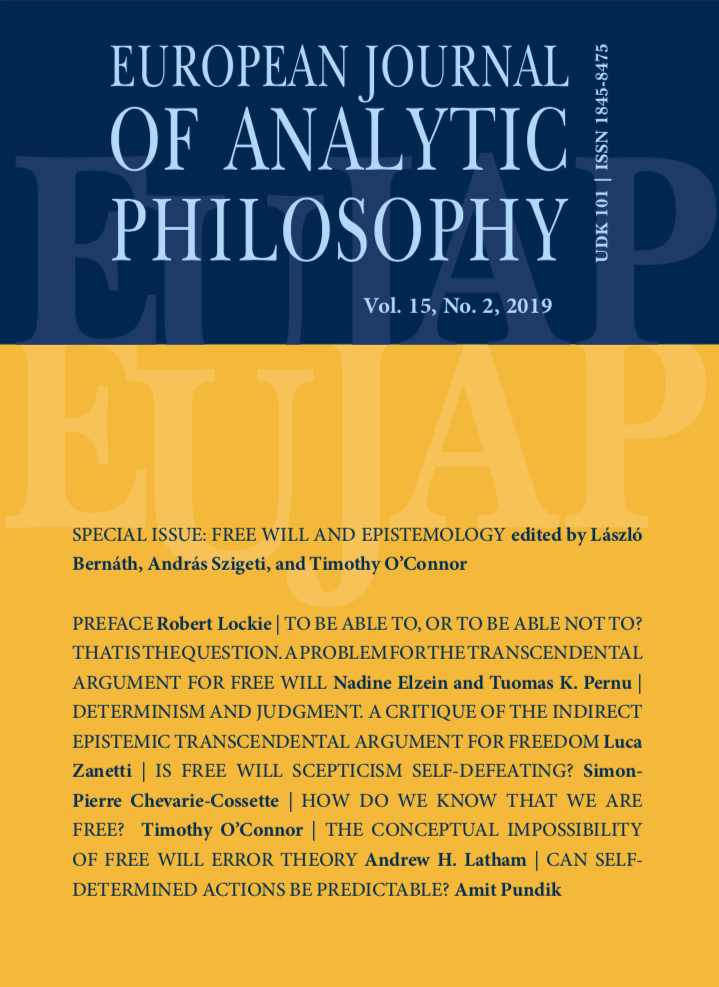DOWNLOAD FULl ISSUE VOL. 21, NO. 1, 2025 (forthcoming)
Book symposium on Katherine Puddifoot’s How Stereotypes Deceive Us
Marina Trakas
Introduction | Pages: 1-8 | Abstract
This is an introduction to the book symposium on Katherine Puddifoot’s How Stereotypes Deceive Us.
Federico José Arena
Part of a book symposium Article 1 | Pages: 9-24 | Abstract | DOI: 10.31820/ejap.21.1.1
Given the pervasive presence of stereotypes’ negative effects, there is a widely shared view according to which almost all stereotypes are harmful. However, some scholars have claimed that we should distinguish between stereotypes: those with and those without statistical support. In her book, Katherine Puddifoot claims that the statistical criterion falls short of what we need to develop a full theory of the epistemology of stereotyping, so she advocates for a Multifactorial view. While I share Puddifoot’s discomfort with the accuracy criterion, in these comments I will put forward some critical considerations. Firstly, I will introduce a methodological concern regarding the discussion about the normative versus non- normative conception of stereotypes. Secondly, I will introduce some doubts about the extent to which the additional factors pointed out by Puddifoot’s Multifactor view, are actually a challenge to the accuracy criterion. Thirdly, I will also critically comment on the argument that not having stereotypes or having egalitarian stereotypes that do not reflect some aspect of social reality improves our chances of attaining certain epistemic ends regarding the perceptions of individuals. Finally, I will briefly introduce a further factor of deception: the normativity of stereotypes, which is not considered within Puddifoot’s proposal.
Leonie Smith
Part of a book symposium Article 2 | Pages: 25-38 | Abstract | DOI: 10.31820/ejap.21.1.2
In How Stereotypes Deceive Us, Katherine Puddifoot provides a convincing non-normative account of what stereotypes are, and of the conditions under which we appropriately rely on them in achieving our epistemic and ethical goals. In this paper, I focus on Puddifoot’s discussion of what she takes to be the non-prejudicial use of accurate stereotypes and their role in causing or perpetuating harm. Such use can cause harm but does not, on the face of it, appear to be wrongful in the way that ordinary cases of prejudicially motivated use of stereotypes are. This raises a challenge for identifying when our use of such stereotypes might be unjust or wrongful (and why). In response, I first suggest that prejudice might be located within the context in which one uses a stereotype, rather than within the content of the stereotype itself. In this way, we can indeed distinguish prejudicial (and therefore wrongful) use of accurate stereotypes from non-prejudicial (innocent) use of accurate stereotypes. And second, I suggest that we also ought to question whether the stereotypes being invoked in all cases really are accurate, given the context and scope of application.
Federico Picinali
Part of a book symposium Article 3 | Pages: 39-56 | Abstract | DOI: 10.31820/ejap.21.1.3
The goal of this paper is to identify and discuss the weaker aspects of some of the arguments in Kathy Puddifoot’s fascinating and thought-provoking book. Section 1 deals with Puddifoot’s treatment of the “single factor view” and the “dual factor view” of stereotyping. Section 2 deals with Puddifoot’s treatment of egalitarian attitudes. Section 3 deals with Puddifoot’s treatment of the moral encroachment approach to stereotyping. Finally, section 4 deals with Puddifoot’s theory of evaluative dispositionalism. The sections can be read independently.
Jennifer Saul
Part of a book symposium Article 4 | Pages: 57-65 | Abstract | DOI: 10.31820/ejap.21.1.4
This paper argues that Puddifoot’s arguments in How Stereotypes Deceive Us have more radical consequences than those argued for in the book. It does this by pointing out two problems for evaluating stereotypes via Evaluative Dispositionalism, Puddifoot’s view. The first problem concerns the very large number of dispositions associated with any stereotype, and the second the difficulty of evaluating a stereotype in isolation from other elements of a person’s psychology. The paper suggests that, when we take seriously Puddifoot’s arguments, we’ll end up concluding that it’s not possible to assess the epistemic worth of any individual belief or stereotype. We could still discuss the epistemic merits of how it was formed, and discuss the epistemic consequences that this belief or stereotype has for a particular person in a particular situation. But overall epistemic evaluations of stereotypes, or even acts of stereotyping, would be something that we should try to avoid.
Katherine Puddifoot
Part of a book symposium Article 5 | Pages: 67- | Abstract | DOI: 10.31820/ejap.21.1.5
This paper provides responses to the 4 commentaries by Federico José Arena, Leonie Smith, Federico Picinali, and Jennifer Saul under the main headings: “Definition of stereotypes”; “Single/dual factor view”, “Epistemic benefits of egalitarian beliefs”, “Beyond stereotyping beliefs”, “Which disposition?”, “More radical implications of evaluative dispositionalism”, “Stereotypes, reality and testimonial injustice”, “Normative stereotypes”, and finally “Moral encroachment”.
BOOK REVIEW
Dino Jelčić
Pages: 91-93 | BOOK REVIEW
BOOK REVIEW Lisa Bortolotti, THE EPISTEMIC INNOCENCE OF IRRATIONAL BELIEFS, Oxford University Press, 2020, ISBN-10: 0198863985, Hardcover: € 57, e-book: € 45.80

